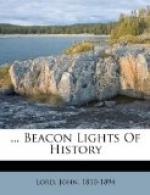A spirit of inquiry having been thus awakened among a few intellectual monks, they began to speculate about those questions which had agitated the Grecian schools: whether genera and species— called “universals,” or ideas—have a substantial and independent existence, or whether they are the creation of our own minds; whether, if they have a real existence, they are material or immaterial essences; whether they exist apart from objects perceptible by the senses. It is singular that such questions should have been discussed in the ninth century, since neither Plato nor Aristotle were studied. Unless in the Irish monastic schools, it may be doubted whether there was a Greek scholar in Western Europe,—or even in Rome.
No very remarkable man arose with a rationalizing spirit, after Erigena, until Berengar of Tours in the eleventh century, who maintained that in the Sacrament the presence of the body of Christ involves no change in the nature and essence of the bread and wine. He was opposed by Lanfranc. But the doctrine of transubstantiation was too deeply grounded in the faith of Christendom to be easily shaken. Controversies seemed to centre around the doctrine of the real existence of ideas,—what are called “universals,”—which doctrine was generally accepted. The monks, in this matter, followed Saint Augustine, who was a realist, as were also the orthodox leaders of the Church generally from his time to that of Saint Bernard. It was a sequence of the belief in the doctrine of the Trinity.
No one of mark opposed the Realism which had now become one of the accepted philosophical opinions of the age, until Roscelin, in the latter part of the eleventh century, denied that universals have a real existence. It was Plato’s doctrine that universals have an independent existence apart from individual objects, and that they exist before the latter (universalia Ante rem,—the thought before the thing); while Aristotle maintained that universals, though possessing a real existence, exist only in individual objects (universalia in re,—the thought in the thing). Nominalism is the doctrine that individuals only have real existence (universalia post rem,—the thought after the thing).




